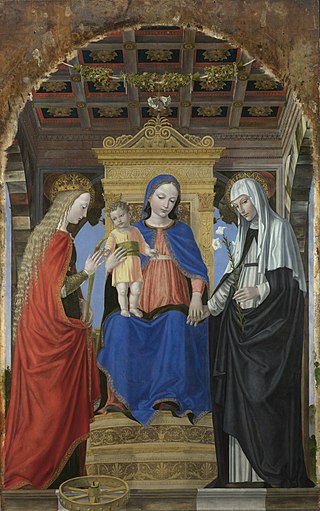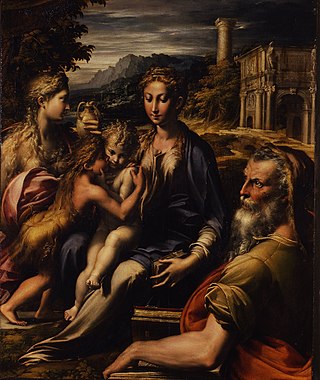
The Santa Margherita Madonna is a 1529-1530 oil on panel painting by Parmigianino, now in the Pinacoteca Nazionale di Bologna. [1]

The Santa Margherita Madonna is a 1529-1530 oil on panel painting by Parmigianino, now in the Pinacoteca Nazionale di Bologna. [1]
A fundamental work from the artist's time in Bologna between 1527 and 1530, it was painted for the nuns of the Santa Margherita convent. In his Lives of the Artists Vasari stated that it showed "Our Lady, Saint Margaret of Antioch, Saint Petronius, Saint Jerome and Saint Michael". [2] In 1686 Malvasia stated it had been commissioned by the Giusti family, but this was in error since that family only owned that chapel from 27 August 1529 onwards and in fact the nuns had on 8 April 1530 given the painting and 150,000 lire in exchange for a house next door to the nunnery from Giovanni Maria Giusti, so that that nobleman could decorate his chapel there as soon as the convent church was complete.
Lamo (1560) and Zanti (1583) both praised the work, adjudging it "one of the rare things, considered extremely rare". In 1674 Scaramuccia stated it was among Guido Reni's favourite paintings, whilst in 1784 father Ireneo Affò called it "the most beautiful of all" the artist's works.

Girolamo Francesco Maria Mazzola, also known as Francesco Mazzola or, more commonly, as Parmigianino, was an Italian Mannerist painter and printmaker active in Florence, Rome, Bologna, and his native city of Parma. His work is characterized by a "refined sensuality" and often elongation of forms and includes Vision of Saint Jerome (1527) and the iconic if somewhat anomalous Madonna with the Long Neck (1534), and he remains the best known artist of the first generation whose whole careers fall into the Mannerist period.

Amico Aspertini, also called Amerigo Aspertini, was an Italian Renaissance painter and sculptor whose complex, eccentric, and eclectic style anticipates Mannerism. He is considered one of the leading exponents of the Bolognese School of painting.

Lorenzo Sabbatini or Sabatini, Sabattini or Sabadini, sometimes referred to as Lorenzino da Bologna, was an Italian painter of the Mannerist period from Bologna.

Catherine of Bologna [Caterina de' Vigri] was an Italian Poor Clare, writer, teacher, mystic, artist, and saint. The patron saint of artists and against temptations, Catherine de' Vigri was venerated for nearly three centuries in her native Bologna before being formally canonized in 1712 by Pope Clement XI. Her feast day is 9 March.

The Basilica of San Domenico is one of the major churches in Bologna, Italy. The remains of Saint Dominic, founder of the Order of Preachers (Dominicans), are buried inside the exquisite shrine Arca di San Domenico, made by Nicola Pisano and his workshop, Arnolfo di Cambio and with later additions by Niccolò dell'Arca and the young Michelangelo.

Francesco Salviati or Francesco de' Rossi was an Italian Mannerist painter who lived and worked in Florence, with periods in Bologna and Venice, ending with a long period in Rome, where he died. He is known by various names, usually the adopted one of Francesco Salviati or Il Salviati, after an early patron, but also Francesco Rossi and Cecchino del Salviati.

Giuliano di Piero di Simone Bugiardini was an Italian Renaissance painter. He was born and was mainly active in Florence. He was a painter primarily of religious subjects but he also executed a number of portraits and a few works with mythological subjects.

Sister Plautilla Nelli (1524–1588) was a self-taught nun-artist and the first ever known female Renaissance painter of Florence. She was a nun of the Dominican convent of St. Catherine of Siena located in Piazza San Marco, Florence, and was heavily influenced by the teachings of Savonarola and by the artwork of Fra Bartolomeo.

The mystical marriage of Saint Catherine covers two different subjects often shown in Catholic art arising from visions received by either Catherine of Alexandria or Catherine of Siena (1347–1380), in which these virgin saints went through a mystical marriage wedding ceremony with Christ, in the presence of the Virgin Mary, consecrating themselves and their virginity to him.

The National Art Gallery of Bologna is a museum in Bologna, Italy. It is located in the former Saint Ignatius Jesuit novitiate of the city's University district, and inside the same building that houses the Academy of Fine Arts. The museum offers a wide collection of Emilian paintings from the 13th to the 18th century and other fundamental works by artists who were in some way related to the city.
(The) Mystic(al) Marriage of Saint/St. Catherine may refer to any of a large number of paintings of the Mystical marriage of Saint Catherine, a few of which are:

Lucrina Fetti was an Italian painter born in Rome under the name Giustina She was the daughter of a lesser-known painter, Pietro Fetti, and the sister and pupil of the more distinguished painter of the family, Domenico Fetti. She accompanied her family to Mantua when her brother was invited to be court painter to Ferdinando Gonzaga, Duke of Mantua. On December 3, 1614, Duke Ferdinando exclusively gave Giustina a dowry of 150 scudi so she could become a Clarissan nun in the Convent of St. Ursula. Once she entered the convent, she chose to change her name to "Lucrina". She was known for her religious works from her family's workshop. They were mostly meant for decorations for the church and convent that were sponsored by Margherita Gonzaga, Duchess of Ferrara. She was also known for doing portraits of the women of the Gonzaga family.

San Paolo is a former convent in central Parma, Emilia-Romagna, northern Italy. It is best known for housing the Camera di San Paolo, decorated by a masterpiece of fresco work (1519) by Correggio.

The Mystic Marriage of St Catherine is a c.1529 oil on panel painting of the mystical marriage of Saint Catherine by Parmigianino, now in the National Gallery, London, who acquired it in 1974. It was engraved by Giulio Bonasone.

Holy Family with the Infant Saint John the Baptist is a painting by Parmigianino, executed c. 1528. It was in the Palazzo Farnese in Rome until 1662, when it moved to Parma. There it hung in the Palazzo del Giardino and later in the Galleria Ducale - the 'Descrizione' of the latter in 1725 called it one of the finest works on display there. It and the rest of the Farnese collection were later moved to Naples and the work was exhibited for a few years in the Palazzo Reale before moving to its present home in the National Museum of Capodimonte. Two early copies remain in the Galleria Nazionale and Palazzo Comunale in Parma.

Adoration of the Magi is an oil on panel painting by Parmigianino, executed c. 1529, now in San Domenico church in Taggia.

Madonna of the Rose is a 1530 oil on panel painting by Parmigianino, now in the Gemäldegalerie in Dresden.

The Kedleston Madonna is a c.1529 oil on canvas painting by Parmigianino, now in the Kimbell Art Museum in Fort Worth, Texas, which acquired it from the Kedleston collection in the United Kingdom in 1995.

Madonna and Child with Saint Zechariah is a c.1530–1533 oil on panel painting by Parmigianino, now in the Uffizi. It shows the Madonna and Child with Zechariah, father of John the Baptist.

Virgin and Child is an unfinished c.1527-1528 oil on panel painting by Parmigianino, now in the Courtauld Gallery in London. As it is usually identified with one which Giorgio Vasari sketched in Bologna and later bought for himself, it is sometimes also known as the Vasari Madonna. The work passed through unknown hands after Vasari, eventually ending up in Lord Kinnard's collection, from whose successors Antoine Seilern acquired it via Colnaghi in 1965 before bequeathing it to the Courtauld in 1978.